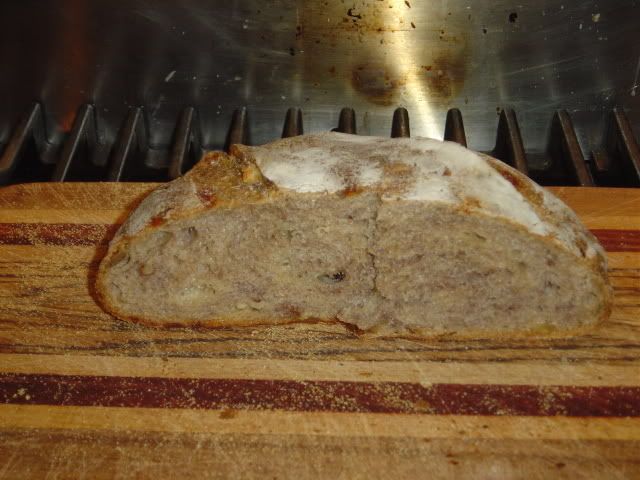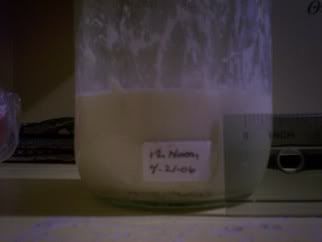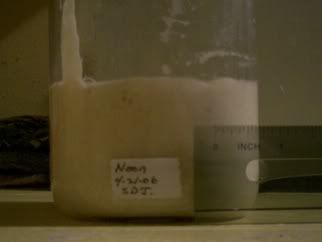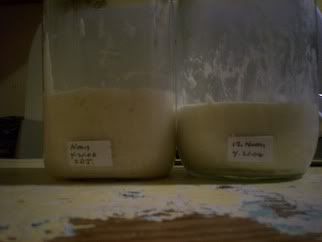I didn't really intend to become a sourdough fanatic, but it seems that's what I make 80% of the time these days. The pound of SAF instant yeast I bought in February is only halfway gone, despite my having baked just about every weekend since then.
Maybe it's because I've had a devil of a time getting my starter to get a decent "sour" and I've been obsessed with getting it right. It wasn't until last month that I finally I cracked it:
1) Stiff (50% hydration) starter,
2) A long, cool bulk rise at about 64-68 degrees (which means, in my cellar), and
3) An overnight retarding in the bottom of my fridge.
I make at least two loaves of the following bread every weekend. One loaf gets wrapped in aluminum foil for the freezer, and the other goes right in the bread box. It's a well-rounded bread with enough flavor to eat on its own, but also a good accompaniment to any sandwich, from peanut butter and banana (a favorite of my Southern roots, though, unlike Elvis, I refrain from frying it in butter), to mustard, turkey pastrami and a sharp cheese.
I also use it as a base for experimentation, adding spices, or fruits, grains or seeds.
It's 100% whole wheat, but to my mind, doesn't taste "whole wheat," at least, not in the usual sense of the word. There's no strong, bitter grassy flavor, though it's a very different flavor than a white flour bread.
Anyway, here's the recipe for my
100% Whole-Wheat Sourdough Sandwich Bread.
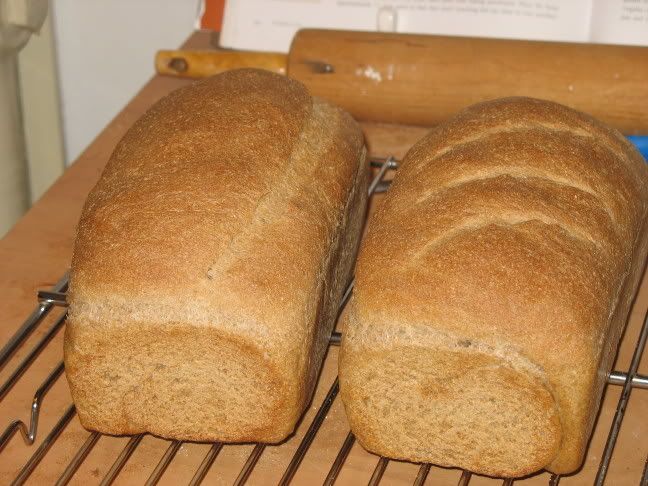
Ingredients
• 19.5 oz whole-wheat flour
• 14.5 oz water (at room temperature)
• 2 Tbs honey
• 2 Tbs Olive Oil
• 2 1/8 tsp salt
• 16.5 oz stiff, whole-wheat sourdough starter (I use a starter at 50 percent hydration)
All the rest
Mix everything EXCEPT the salt and the starter together until you get a rough dough. Let it sit for 30-60 minutes so that the whole-wheat flour can absorb the water. This cuts down on the kneading time substantially. Without the "autolyse," you'll have to knead by hand for 30 minutes or more to get it to the right place.
Tear the starter into about 10 pieces. Add the starter and the salt to the rest of the ingredients DON'T FORGET TO ADD THE SALT (like I almost always come close to doing). Tastes awful if you forget it.
Knead the dough until you can stretch a tiny bit of it into a translucent membrane. You'll see plenty of bran blocking the light, but that's ok so long as the surrounding dough is translucent. Oil a bowl or container, put the dough in it and cover.
When it has doubled -- and this may take 3-4 hours depending on the temperature -- fold it and let it rise again. This second rise improves flavor and helps the final loaf rise higher. It should take about half the amount of time the previous rise took.
Once it has risen a second time, remove the dough and divide it in half. Shape each piece into a loaf, and place inside two oiled 8.5 inch by 4.5 inch loaf pans. To shape the loaves, I pat and stretch each portion of the dough into a rough 8"x4" rectangle. I then take one of the 4" ends, and roll it up, pausing every full turn to press down hard on the seam with the edge of my hand. Once the loaf is rolled and sealed, II then stretch it gently so that it's longer than the pan, and fold the edges underneath, again, pressing down hard to seal the seams. I then rock it back and forth quickly while bringing my hands from the middle of the loaf to the edges to stretch it out once again to fit the pan.
Here, you have a choice. You can either cover the pans with food grade plastic and stick it in the fridge overnight, or you can just let it rise and bake immediately. Retarding overnight will accentuate the flavor, and the sourness, of the bread. Depending on how sour your starter is, retarding might overdo the sourness.
Let the loaves rise until they crest about an inch or two in the center of the loaf above the rim of the pan. Try to catch it so that, when you poke the loaf with a damp finger, the indention starts to fill back in slowly. If you've retarded the bread, and it's already at this stage, you can either leave it out (covered) for about an hour to warm up or bake it immediately. I've had more luck getting oven spring if I warm it up.
Otherwise, let it rise until it's nearly fully risen. Meanwhile, preheat the oven to 350 degrees F.
Slash the loaves artfully. These days, I like a few baguette-style slashes on a slight diagonal along the length of the loaf. But, really, it's up to you. As you can see from the photos, I've taken other approaches in the past.
Put the loaves in to bake and, If you wish, steam the oven by pouring 1-2 cups of boiling water into a pre-heated pan or skillet in the bottom of the oven. If find this results in a darker crust, and slighly larger loaves.
Cook for about 40 minutes in a preheated oven at 350 degrees, until the center of each loaf registers 190 to 200 degrees. Remove from pans and cool for 1 hour before slicing.
A couple of variations:
Cinnamon-raisin sourdough: Substitute 2 TBS butter for the olive oil and raise the honey to 4 TBS. Add 2 tsp cinnamon. Near the end of the kneading, add 9 oz raisins and, if you like, 4 oz pecans or walnuts. The extra cinnamon and honey will increase the rising time by about 40%, and you'll need 9"x5" pans. Add 15-20 minutes to the bake.
Multi-grain sourdough Soak 6 oz of your favorite seeds and grains (sunflower seeds, flax seeds, rye chops, wheat berries, oat groats, whatever mix suits your fancy) in 6 oz of water overnight. Reduce the water in the dough to 11.5 oz. Use a 9"x5" pan and add 15-20 minutes to the bake.









